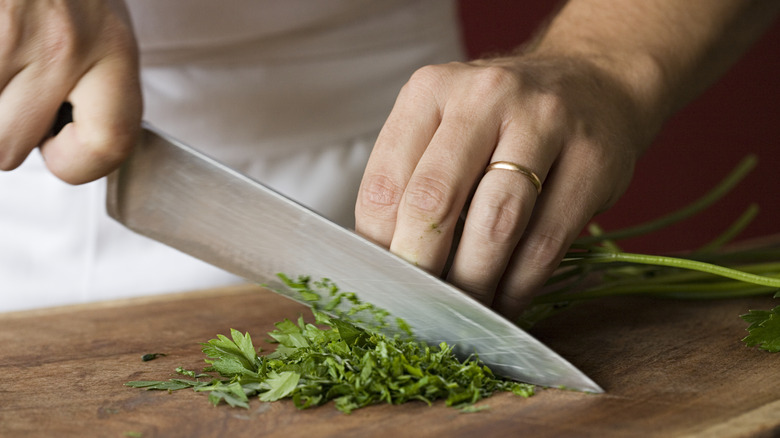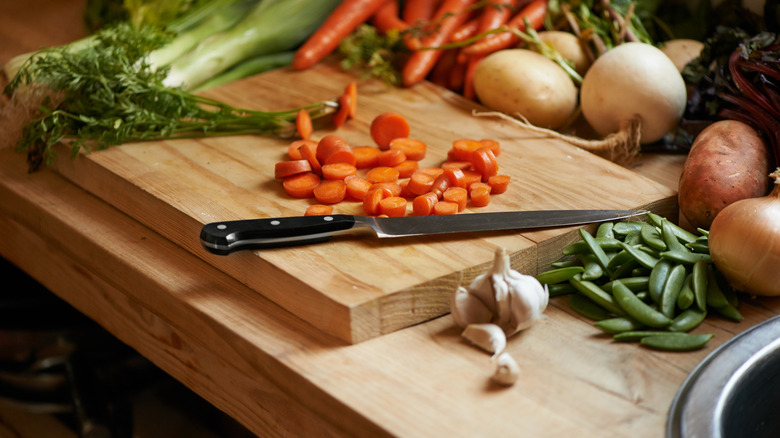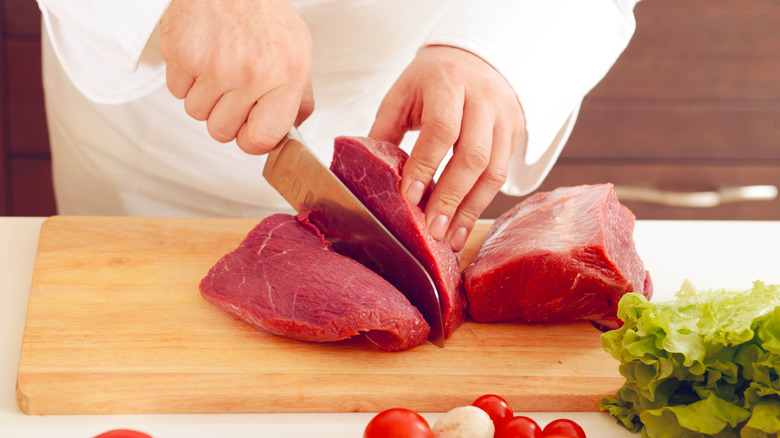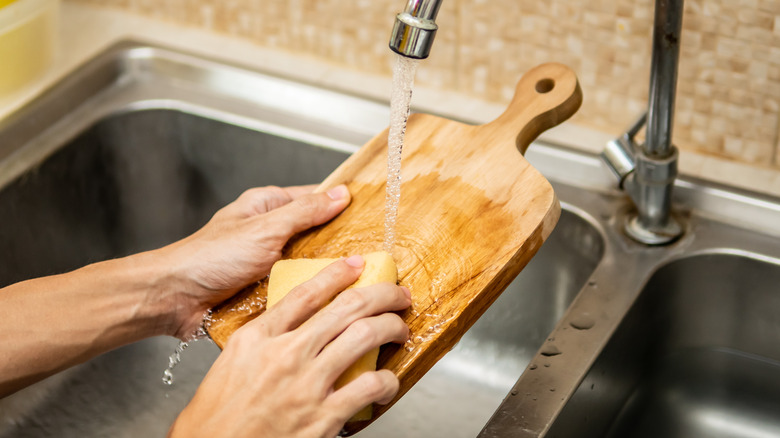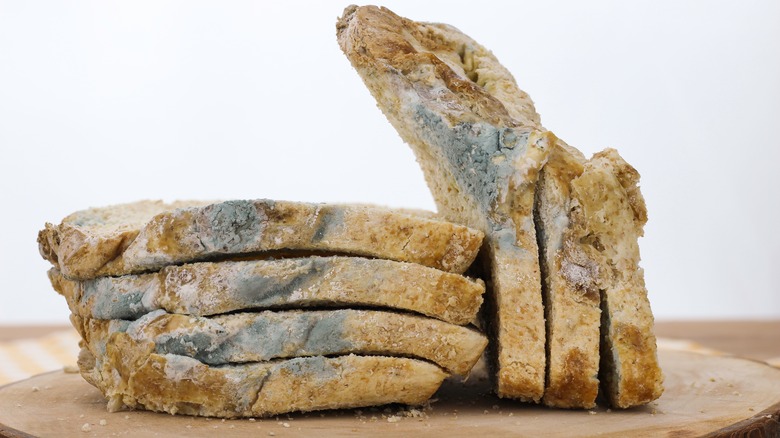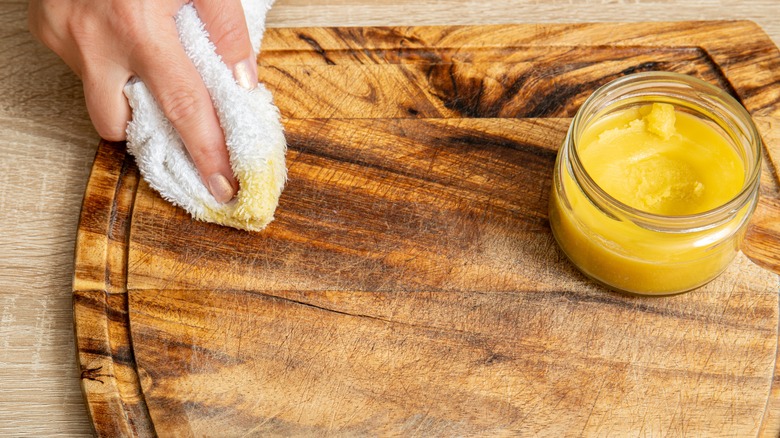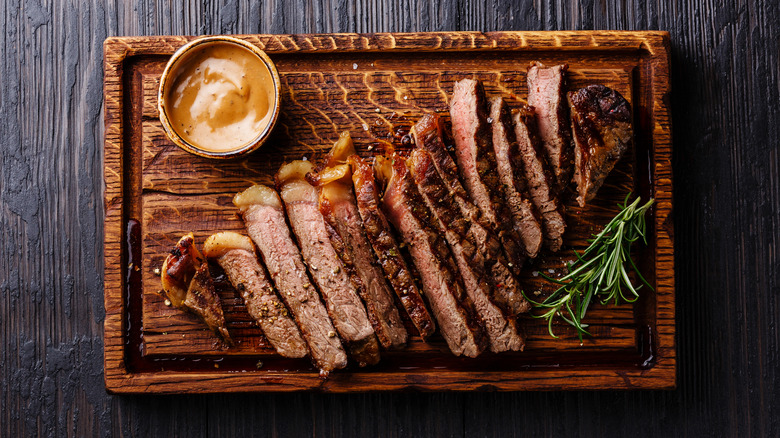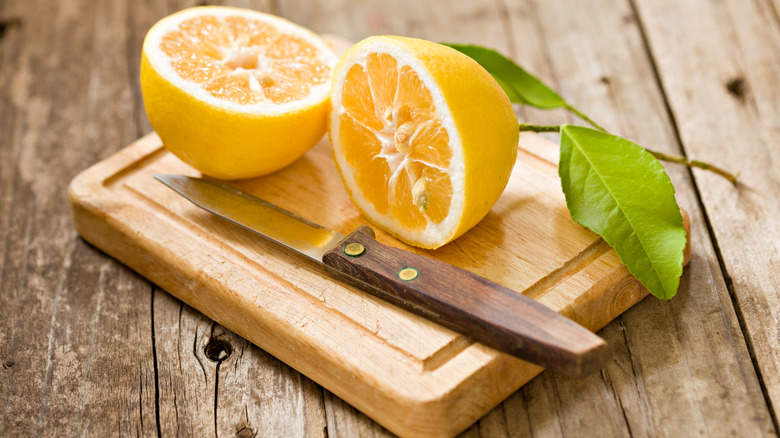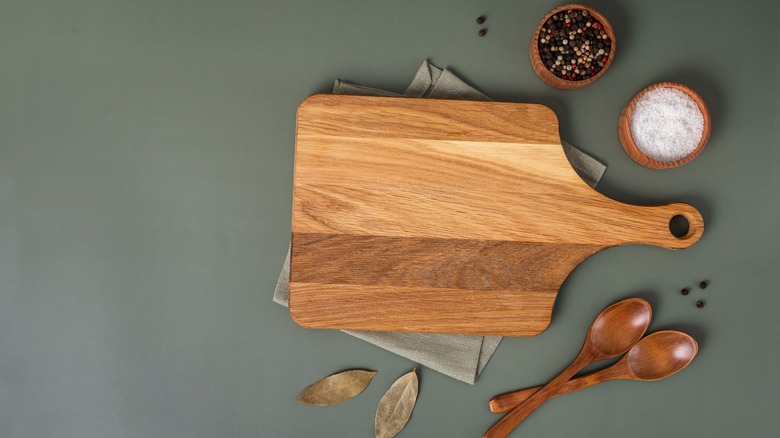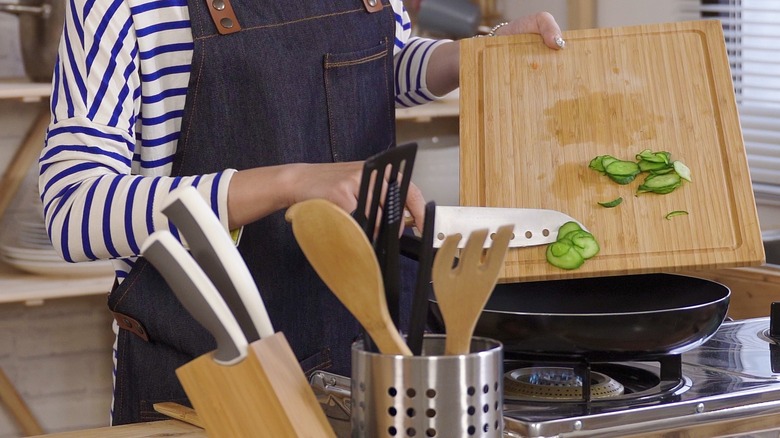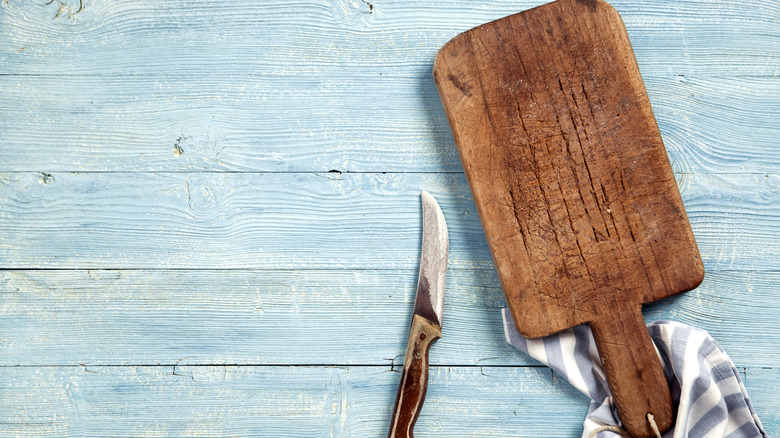Common Cutting Board Mistakes And How To Avoid Them
Cutting boards are a staple in most kitchens. They make it easy to cut meats, produce, and breads, prevent countertops from damage, help contain cooking messes, and contribute to kitchen safety. They also come in many sizes and materials, so you can find the perfect one to fit your style and needs.
While using a cutting board seems like it should be intuitive, there are a few wrong ways to use a cutting board. These can lead to unsafe practices that leave you open to things like knife injuries, food poisoning, or recipes that just don't turn out the way they should. Kitchen mistakes can happen to even the most experienced chef, but knowing how to properly use your cutting board will help you prepare tasty, safe-to-eat food without the risk of injury or illness. Here are some of the most common cutting board mistakes and tips for how to avoid them.
Choosing the wrong material cutting board
You can find cutting boards in a variety of materials, including wood, plastic, and glass. Unfortunately, using the wrong type of cutting board can make cutting food harder and even dangerous.
Each type of cutting board material has pros and cons. Glass won't absorb bacteria, but it can dull your knife, break easily, and become slippery, making it dangerous. Plastic cutting boards are dishwasher safe and affordable, but they can develop grooves that are hard to clean and harbor bacteria.
Wood cutting boards are a popular choice. They're softer, so they won't dull knives, and typically last longer than plastic cutting boards. However, they can be harder to maintain, and because they're porous, they can harbor bacteria and cause cross-contamination.
The United States Department of Agriculture (USDA) recommends bamboo cutting boards. Bamboo isn't as porous as other types of wood, so they're easier to clean and are less prone to bacterial growth. Unfortunately, this also means they're harder and can dull your knives if you aren't careful.
Using the same cutting board for everything
Cross-contamination happens when bacteria or allergens from one food product find their way onto another food product. This can make you sick and be especially dangerous for someone with food allergies.
Raw meat and poultry are especially concerning when it comes to cross-contamination. Salmonella and E.coli are some of the most well-known contaminants found in these foods, but raw meat and poultry can host a wide range of germs and bacteria that cause food poisoning.
The best way to prevent cross-contamination is to use more than one cutting board. The USDA recommends using one cutting board for raw meat, poultry, and shellfish, and a second one for produce, bread, and foods you don't plan on cooking. This prevents the bacteria from raw meat and poultry from contaminating other foods.
If there are allergy concerns, you should also use a separate cutting board when cooking with that allergen. This prevents the allergen from spreading onto other foods and potentially causing an allergic reaction.
Not properly sanitizing your cutting board
Because some types of cutting boards can harbor bacteria, cross-contamination may also occur if you don't properly clean and sanitize your cutting boards. This can lead to food poisoning, so it's extremely important that you follow safety guidelines for cleaning your cutting board.
Some cutting boards can be washed in the dishwasher, but many, especially those made of wood, cannot. In this case, wood cutting boards should be washed thoroughly in hot, soapy water on both sides immediately after use. After cutting raw meat, poultry, or chicken, you should wash your cutting board in hot, soapy water and disinfect it.
To disinfect your cutting board, soak it in a solution of one tablespoon of liquid bleach per gallon of water. Let it soak for several minutes to ensure all germs and bacteria have been completely destroyed. After washing and disinfecting your cutting board, rinse it with water to remove all soap and bleach. Then you can either pat it dry with clean paper towels or allow it to air dry. Make sure your cutting board is completely dry before storing it.
Putting your cutting board away while it's still wet
Mold and mildew love dark, damp environments, and when you put your cutting boards, especially wooden ones, away while they're still wet, you create the perfect haven for fungus to thrive. The spores find their way in through pores, cracks, or cuts, and once they've taken root, they can be difficult to destroy.
When mold is in your cutting board, it can leach into your food. This can completely ruin some foods — imagine slicing a fresh loaf of bread, storing it away, and later discovering it's covered in mold. Not all mold is dangerous, but it's impossible to identify mold just by looking at it, so moldy food should be discarded to avoid making someone ill. Some types of mold can cause respiratory problems, nausea, and vomiting. It's especially dangerous for those who have mold-based allergies.
Mild mold and mildew can be neutralized using the same bleach solution of one tablespoon of liquid bleach per gallon of water as mentioned above. Soak the board for several minutes, rinse with water, then pat it dry or let it air dry completely, preferably in a drying rack. You may still notice some traces of the mold, like discoloration, but it can't hurt you. However, if your cutting board is covered in fuzz or spots, it's safest just to throw it away.
Forgetting to season your cutting board
One of the best ways to protect and prolong the life of your wooden cutting board is to season it, meaning coat it in oil. This serves two purposes. First, it fills the pores of the wood, which prevents bacteria and other nasty pathogens from seeping into the board. It also hydrates the wood, making it less likely that your board will crack or splinter.
To season your board, choose a food-safe mineral oil, linseed oil, or beeswax. You can also find products made specifically for cutting boards, such as a cutting board cream. Pour a few tablespoons over a clean, dry cutting board, enough to flood the board. Next, use a soft cloth or paper towel to rub the oil in a circular motion across the board, covering every nook and cranny. You can also apply the product directly to the towel and proceed to rub it into the wood. Wipe away any excess oil; your board should not be dripping with oil once you're finished.
It's usually a good idea to repeat this process, especially on a board that hasn't been oiled before. Then let the board air-dry overnight, wiping it down once more before putting it away. Oil your cutting board about once a month, depending on how often you use the board. This method can also be used to protect other wooden kitchen tools, like wooden spoons or spatulas.
Not picking a cutting board with wells
You may notice that some cutting boards have grooves or divots carved into their surfaces. These are called wells or juice canals, and they do a very important job: they catch the liquid that comes out of foods when you cut them.
Chicken, for example, tends to produce a lot of juices when it's cut, especially if it's been defrosted. The wells catch this juice, preventing it and the harmful bacteria it can carry from spilling onto your counter or table. They can also catch the sticky juices from cut fruit or water from recently rinsed vegetables, making cleanup a breeze. Just be sure to transfer your wet cutting board to the sink without spilling! Serving up savory pork tenderloin or tender steak? A nice wooden cutting board with wells can double as a serving board, catching all the juices so they don't go to waste.
Wells or juice canals in cutting boards are great for containing mess, but they do need to be carefully cared for. When cleaning, ensure that you scrub along all the wells, and make sure that you completely oil the wells when seasoning your cutting board.
Cutting on a board that's too small
Small cutting boards are cute and easy to store, but they aren't always the most efficient or the safest. A cutting board that's too small for the food you're cutting can lead to a mess. It can also make it difficult to maneuver the knife effectively, which can cause you to lose control of the knife and potentially hurt yourself.
There are a few things to consider when choosing the right-sized cutting board. First, it needs to fit your space. You should be able to set your cutting board flat on the counter without any obstacles or anything that it could bump into and knock over. The size of the food you're cutting is also important. A small cutting board is suitable for slicing lemons or apples, but trying to cut a whole loaf of bread on a small cutting board will leave you with crumbs everywhere.
Your cutting board also needs to be large enough for the knife you're using. A paring knife suits a small board just fine, but a chef's knife needs a board that matches its size. You should be able to lay your knife diagonally across the board, ideally with an extra inch of board on both ends of the knife.
You aren't securing your cutting board
Failing to secure your cutting board is another mistake that can make cooking messy or dangerous. A cutting board that's slipping and sliding across your countertop may spill juices everywhere and make it more likely that you'll lose control of your knife and you'll cut yourself.
Before laying down your cutting board, check that both the surface, such as a counter, and the cutting board are dry. If either is wet, the board is more likely to slip, especially if the board is glass or plastic. Mop up any spills before setting your cutting board down. Some cutting boards come with grippy feet on the bottom, but you can also buy these and attach them yourself. Some stick on, while there are others that you screw on for a more secure fit. You can also find cutting board mats that are made specifically to help stabilize your cutting board.
In a pinch, using a damp paper towel will also do. Wet a few paper towels, squeeze out the excess water, lay them flat on the countertop, and place the cutting board on top. This will help keep the cutting board in place. Other materials you can use include a damp kitchen towel or kitchen liner mesh. Whatever you use does not need to be the same size as the cutting board.
Scraping your knife against your cutting board
It's a common habit — you've finished chopping your chicken or veggies, and now it's time to cook them in the waiting pot. So you lift your cutting board, and, using the edge of your knife, scrape the food in. Unfortunately, this is a habit that's bad for both your knife and your cutting board.
When you use a knife in this way, scraping it against the board, the knife quickly becomes dull. A dull knife makes cutting more of a challenge, and it may shred your food rather than give you clean-edged cuts. You also may feel the need to use more pressure or force to cut your food, and as a result, it's more difficult to control the knife and can become a safety hazard.
This extra pressure is bad for your cutting board, too, leading to more nicks and scrapes against the board. Not only does this look unsightly, but it creates hard-to-clean areas where bacteria and mold can settle and multiply. Additionally, scraping your knife against your cutting board can shave off bits of wood on a wooden cutting board or plastic on a plastic cutting board, and no one wants slivers or microplastics in their food. If your cutting board is glass, well, it just makes a really obnoxious sound.
Instead, you can use the non-sharp edge of your knife to scrape food off your cutting board. Other options include forks, kitchen spoons, spatulas, and even your hands — so long as they're clean!
Continuing to use a damaged cutting board
Ideally, your cutting board should last you several years. Most plastic boards last at least a year with regular use, and proper maintenance of a wooden cutting board can help it last even longer. But if your cutting board is starting to get up there in years or show major signs of damage, it's time to replace it.
If your cutting board has become warped, no matter the material, it needs to be thrown out. A warped board creates an uneven and unstable cutting surface. This can cause juices to overflow the cutting board, spilling bacteria or sticky liquid all over your countertops. It can also make it very difficult to control your knife, putting you at risk for injury.
A plastic cutting board with deep cuts or grooves also has to go. There's no way to repair these, and as we've mentioned, crannies like these in your cutting board are a great place for microorganisms to hang out and reproduce.
Cuts and grooves on a wooden cutting board may be fixable, however. You may be able to sand down the surface of the board to get rid of these imperfections, after which you should rinse, dry, and re-season your cutting board. However, if your cutting board has deep cuts that can't be sanded down, it's not salvageable. Additionally, a wooden cutting board with cracks can't be fixed and should be tossed.
